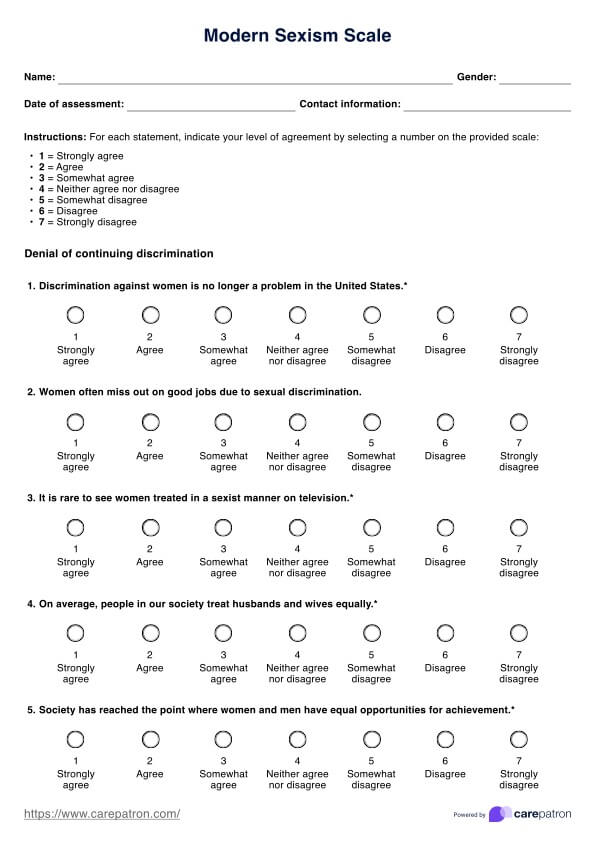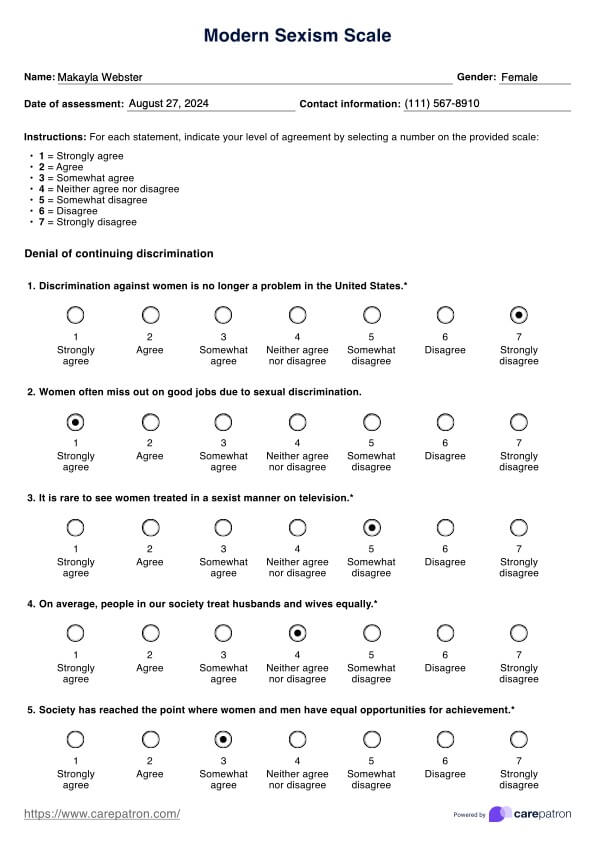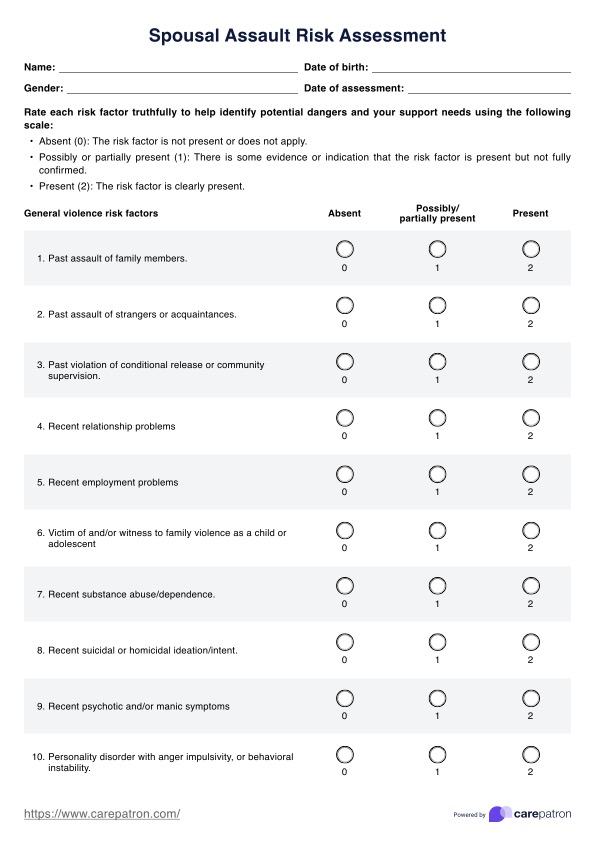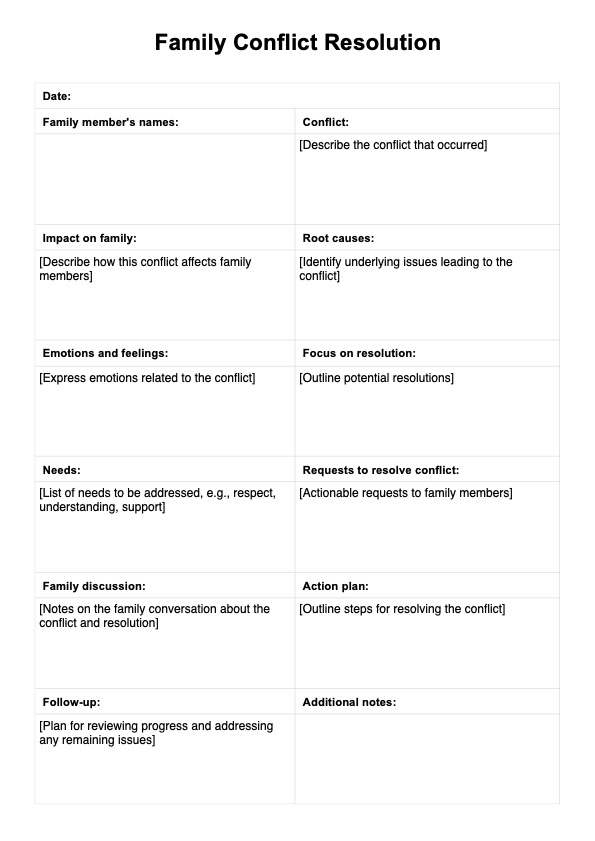Modern Sexism Scale (MSS)
Download Carepatron's Modern Sexism Scale (MSS) PDF and learn more about measuring gender bias and attitudes with this useful tool.


What is the Modern Sexism Scale (MSS)?
The Modern Sexism Scale (MSS) is a tool used to measure subtle forms of sexism that have evolved over the past few years. Unlike overt sexism, which is easily recognized, modern sexism manifests through more covert and socially acceptable behaviors and attitudes. The MSS evaluates negative attitudes toward gender equality and gender-related policies, often reflecting skepticism or gender differences in women's actual experiences.
The MSS is particularly valuable in understanding attitudes equivalence across racial ethnic groups, as it can reveal how sexism intersects with other forms of sexual discrimination and gender discrimination. It also examines how societal institutions, including government and news media, shape and perpetuate these attitudes, which play a significant role in framing public discourse on gender issues.
By examining the beliefs held by different racial, ethnic, and gender groups, the MSS contributes to how these attitudes influence societal dynamics. It complements tools like the Ambivalent Sexism Inventory, Symbolic Racism Scale (SRS), and the Hostile Sexism Scale, offering a broader view of gender-related biases.
The Modern Sexism Scale plays a crucial role in identifying and addressing subtle forms of sexual discrimination, helping researchers and policymakers develop more effective strategies for promoting gender equality.
Modern Sexism Scale (MSS) Template
Modern Sexism Scale (MSS) Example
How to use our Modern Sexism Scale (MSS) template
Our Modern Sexism Scale testing measurement template is valuable for healthcare professionals looking to assess subtle sexist attitudes in their clients or patients. This template is designed to be easy to use, helping you gather insights to inform your treatment approach. By following these simple steps, you can effectively integrate the MSS into your practice.
Access and download the PDF scale
To begin, access Carepatron's platform and download the Modern Sexism Scale (MSS) PDF. You can access the PDF from Carepatron's resource library or through the preview on this page.
Review the scale
Before introducing the scale to your patients, take a few moments to review the contents of the PDF. Familiarize yourself with the questions and the response format. Understanding the scale thoroughly will enable you to confidently guide your patients through it and address any questions they may have.
Introduce and use the scale with the patient
When you meet with your patient, introduce the Modern Sexism Scale by explaining its purpose and importance in assessing subtle gender-related attitudes. Make sure to emphasize that the scale is a tool for understanding perspectives across various ethnic and gender groups. Guide the patient through each question, ensuring they understand the statements and feel comfortable responding honestly.
Provide and explain results
After the patient completes the scale, review the results with them. Explain what their scores indicate, particularly in relation to negative attitudes, gender equality, and gender-related policies. Discuss how these results might relate to their experiences or perspectives, and use this information to inform any treatment plans or interventions. Your explanation should be clear and supportive, helping the patient understand their results in the context of broader societal attitudes and personal experiences.
Scoring
The Modern Sexism Scale (MSS) is scored using a 7-point Likert scale, where respondents indicate their level of agreement with each statement, ranging from "strongly agree" (1) to "strongly disagree" (7). Some items are reverse-scored to ensure accuracy in measuring subtle sexist attitudes. Once all responses are recorded, the item scores are averaged to produce a final score.
This average reflects the respondent's overall stance on modern sexism. Higher scores indicate a greater endorsement of modern sexist attitudes, meaning that a higher total score suggests more agreement with sexist beliefs. Conversely, lower scores indicate less agreement with these attitudes, reflecting a more egalitarian view.
Next steps after using the scale
After administering and scoring the Modern Sexism Scale (MSS), healthcare professionals should take several important steps. First, review the results in the context of the patient’s overall mental and emotional health, considering how their attitudes might impact their well-being or interactions with others. If the results indicate significant biases, consider integrating discussions about gender equality into therapy or counseling sessions. This can help patients explore their attitudes and develop more inclusive perspectives.
Additionally, the patient’s record findings should be documented to track any changes in their views over time, especially if the MSS is used in follow-up assessments. If necessary, refer the patient to specialized services or resources addressing gender-related issues. Finally, consider using the data for future research or to inform gender-sensitive practices within your healthcare setting, contributing to ongoing efforts to understand and mitigate subtle forms of sexism.
Commonly asked questions
The Modern Sexism Scale measures subtle, often socially acceptable forms of sexism that deny or downplay gender inequality. It assesses negative attitudes toward gender-related policies and beliefs that sexism is no longer a significant issue.
The Neo-Sexism Scale evaluates covert and modern forms of sexism that express resistance to gender equality, often through rationalizations that appear neutral or non-prejudiced. It closely relates to the Modern Sexism Scale by addressing similar subtle biases.
Examples of modern sexism include believing that gender equality has already been achieved or that efforts to promote women's rights are unnecessary. It also includes viewing discussions about sexism as exaggerated or irrelevant.
Traditional sexism overtly and openly endorses gender inequality, often through explicit statements about male superiority. Modern sexism, on the other hand, is subtler, characterized by denial of ongoing discrimination and resistance to policies aimed at achieving gender equality.




















-template.jpg)



















































































